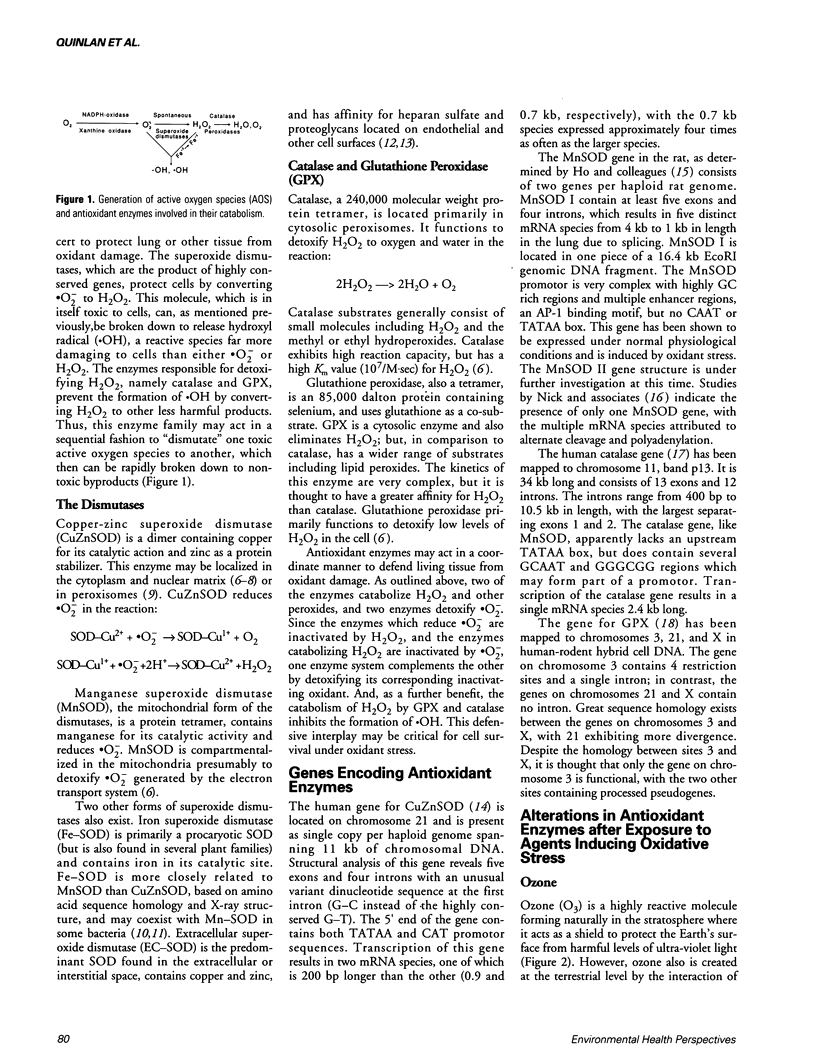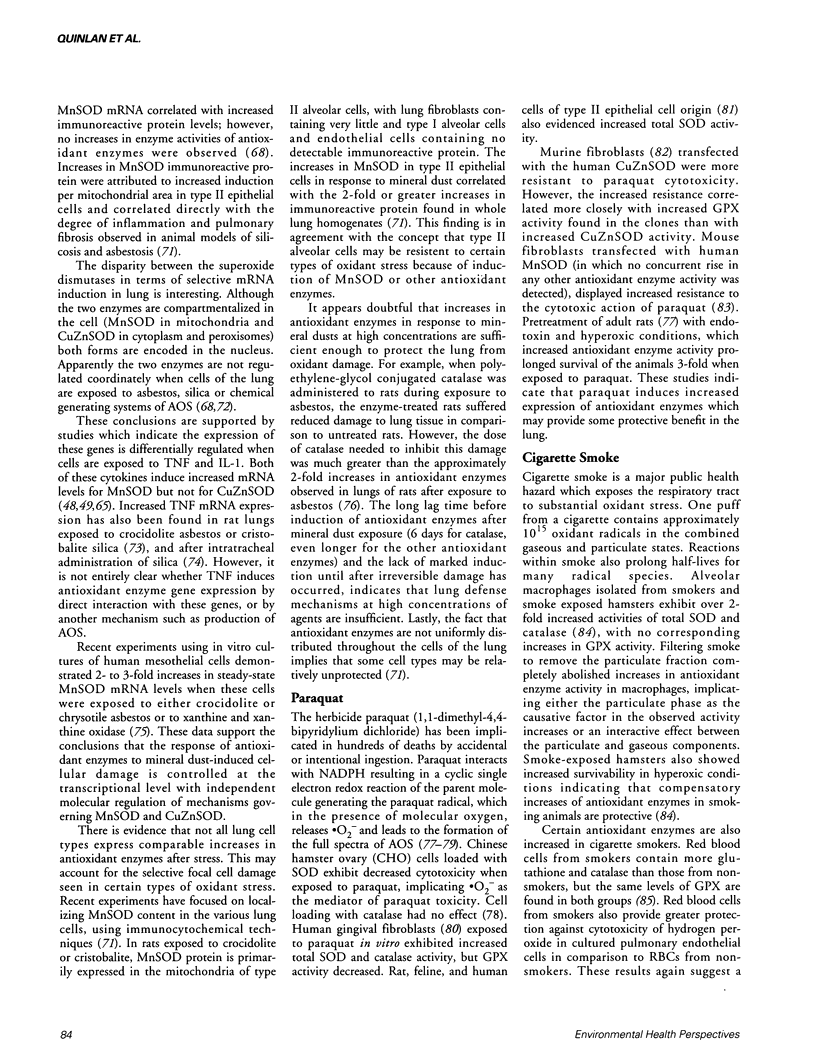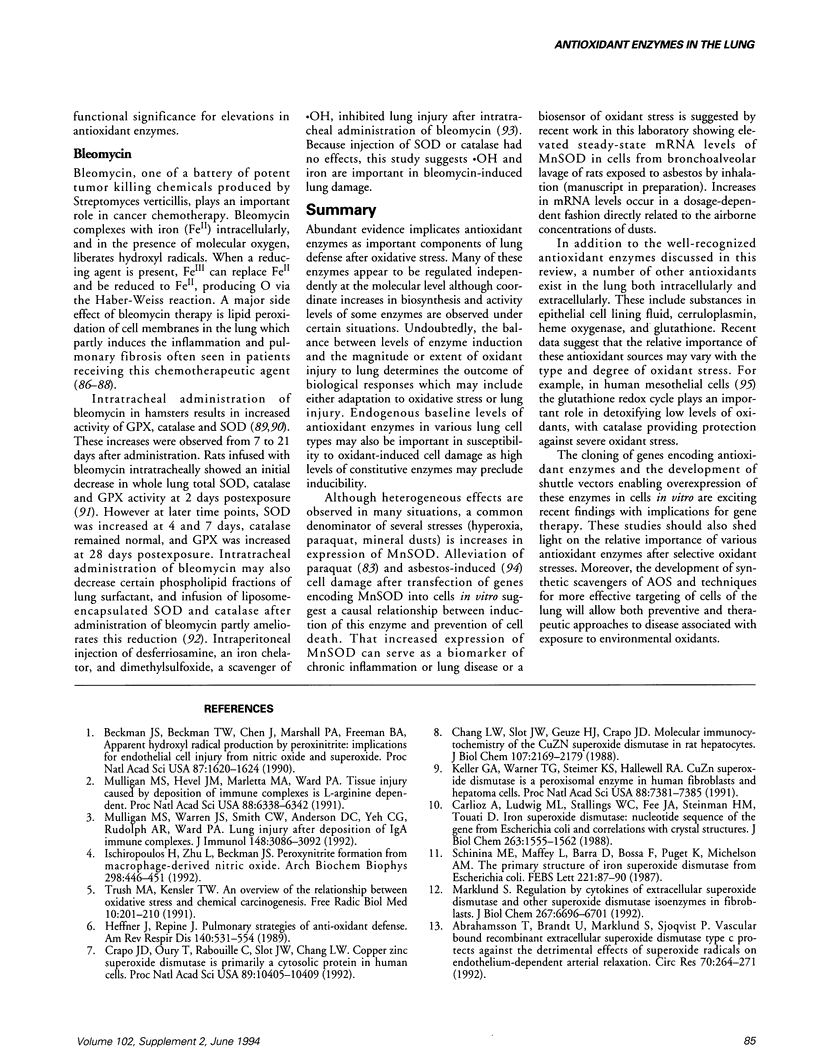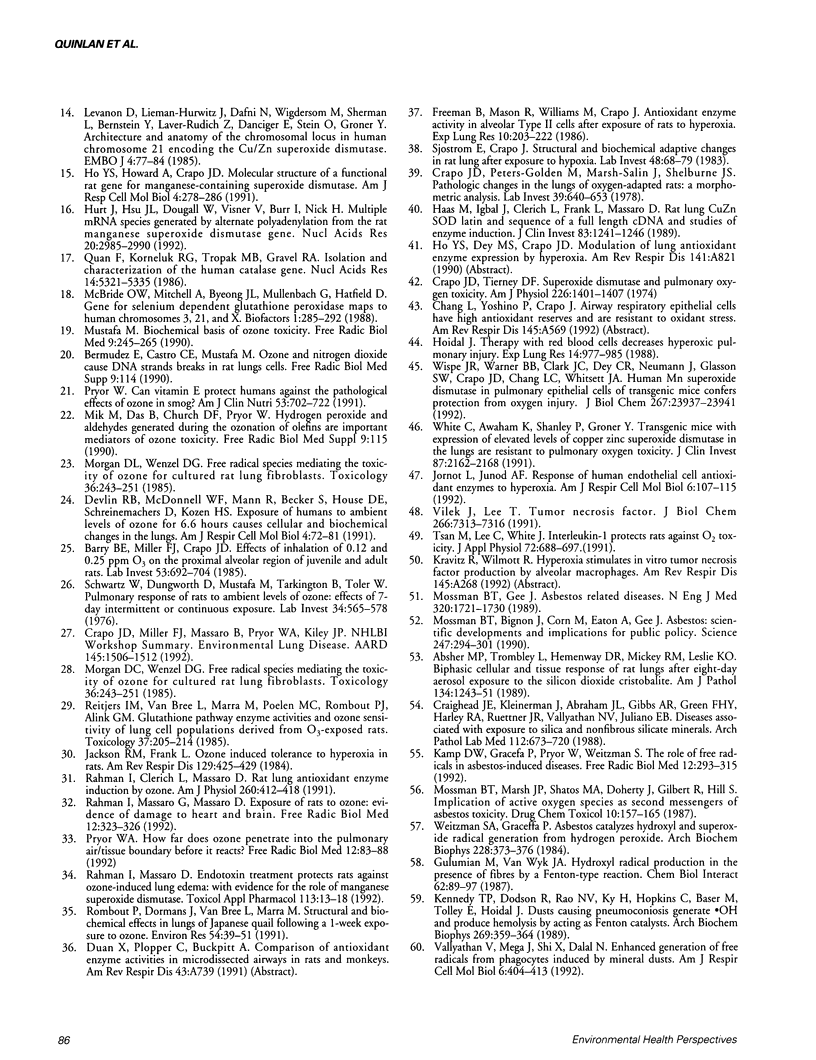Abstract
Studies have implicated active oxygen species (AOS) in the pathogenesis of various lung diseases. Many chemical and physical agents in the environment are potent generators of AOS, including ozone, hyperoxia, mineral dusts, paraquat, etc. These agents produce AOS by different mechanisms, but frequently the lung is the primary target of toxicity, and exposure results in damage to lung tissue to varying degrees. The lung has developed defenses to AOS-mediated damage, which include antioxidant enzymes, the superoxide dismutases [copper-zinc (CuZnSOD) and manganese-containing (MnSOD)], catalase, and glutathione peroxidase (GPX). In this review, antioxidant defenses to environmental stresses in the lung as well as in isolated pulmonary cells following exposure to a number of different oxidants, are summarized. Each oxidant appears to induce a different pattern of antioxidant enzyme response in the lung, although some common trends, i.e., induction of MnSOD following oxidants inducing inflammation or pulmonary fibrosis, in responses to oxidants occur. Responses may vary between the different cell types in the lung as a function of cell-cycle or other factors. Increases in MnSOD mRNA or immunoreactive protein in response to certain oxidants may serve as a biomarker of AOS-mediated damage in the lung.
Full text
PDF








Images in this article
Selected References
These references are in PubMed. This may not be the complete list of references from this article.
- Abrahamsson T., Brandt U., Marklund S. L., Sjöqvist P. O. Vascular bound recombinant extracellular superoxide dismutase type C protects against the detrimental effects of superoxide radicals on endothelium-dependent arterial relaxation. Circ Res. 1992 Feb;70(2):264–271. doi: 10.1161/01.res.70.2.264. [DOI] [PubMed] [Google Scholar]
- Absher M. P., Trombley L., Hemenway D. R., Mickey R. M., Leslie K. O. Biphasic cellular and tissue response of rat lungs after eight-day aerosol exposure to the silicon dioxide cristobalite. Am J Pathol. 1989 Jun;134(6):1243–1251. [PMC free article] [PubMed] [Google Scholar]
- Bagley A. C., Krall J., Lynch R. E. Superoxide mediates the toxicity of paraquat for Chinese hamster ovary cells. Proc Natl Acad Sci U S A. 1986 May;83(10):3189–3193. doi: 10.1073/pnas.83.10.3189. [DOI] [PMC free article] [PubMed] [Google Scholar]
- Barry B. E., Miller F. J., Crapo J. D. Effects of inhalation of 0.12 and 0.25 parts per million ozone on the proximal alveolar region of juvenile and adult rats. Lab Invest. 1985 Dec;53(6):692–704. [PubMed] [Google Scholar]
- Beckman J. S., Beckman T. W., Chen J., Marshall P. A., Freeman B. A. Apparent hydroxyl radical production by peroxynitrite: implications for endothelial injury from nitric oxide and superoxide. Proc Natl Acad Sci U S A. 1990 Feb;87(4):1620–1624. doi: 10.1073/pnas.87.4.1620. [DOI] [PMC free article] [PubMed] [Google Scholar]
- Bus J. S., Gibson J. E. Paraquat: model for oxidant-initiated toxicity. Environ Health Perspect. 1984 Apr;55:37–46. doi: 10.1289/ehp.845537. [DOI] [PMC free article] [PubMed] [Google Scholar]
- Carlioz A., Ludwig M. L., Stallings W. C., Fee J. A., Steinman H. M., Touati D. Iron superoxide dismutase. Nucleotide sequence of the gene from Escherichia coli K12 and correlations with crystal structures. J Biol Chem. 1988 Jan 25;263(3):1555–1562. [PubMed] [Google Scholar]
- Chang L. Y., Slot J. W., Geuze H. J., Crapo J. D. Molecular immunocytochemistry of the CuZn superoxide dismutase in rat hepatocytes. J Cell Biol. 1988 Dec;107(6 Pt 1):2169–2179. doi: 10.1083/jcb.107.6.2169. [DOI] [PMC free article] [PubMed] [Google Scholar]
- Crapo J. D., Oury T., Rabouille C., Slot J. W., Chang L. Y. Copper,zinc superoxide dismutase is primarily a cytosolic protein in human cells. Proc Natl Acad Sci U S A. 1992 Nov 1;89(21):10405–10409. doi: 10.1073/pnas.89.21.10405. [DOI] [PMC free article] [PubMed] [Google Scholar]
- Crapo J. D., Peters-Golden M., Marsh-Salin J., Shelburne J. S. Pathologic changes in the lungs of oxygen-adapted rats: a morphometric analysis. Lab Invest. 1978 Dec;39(6):640–653. [PubMed] [Google Scholar]
- Crapo J. D., Tierney D. F. Superoxide dismutase and pulmonary oxygen toxicity. Am J Physiol. 1974 Jun;226(6):1401–1407. doi: 10.1152/ajplegacy.1974.226.6.1401. [DOI] [PubMed] [Google Scholar]
- Crapo J., Miller F. J., Mossman B., Pryor W. A., Kiley J. P. NHLBI workshop summary. Environmental lung diseases. Relationship between acute inflammatory responses to air pollutants and chronic lung disease. Am Rev Respir Dis. 1992 Jun;145(6):1506–1512. doi: 10.1164/ajrccm/145.6.1506. [DOI] [PubMed] [Google Scholar]
- Devlin R. B., McDonnell W. F., Mann R., Becker S., House D. E., Schreinemachers D., Koren H. S. Exposure of humans to ambient levels of ozone for 6.6 hours causes cellular and biochemical changes in the lung. Am J Respir Cell Mol Biol. 1991 Jan;4(1):72–81. doi: 10.1165/ajrcmb/4.1.72. [DOI] [PubMed] [Google Scholar]
- Diseases associated with exposure to silica and nonfibrous silicate minerals. Silicosis and Silicate Disease Committee. Arch Pathol Lab Med. 1988 Jul;112(7):673–720. [PubMed] [Google Scholar]
- Fantone J. C., Phan S. H. Oxygen metabolite detoxifying enzyme levels in bleomycin-induced fibrotic lungs. Free Radic Biol Med. 1988;4(6):399–402. doi: 10.1016/0891-5849(88)90091-3. [DOI] [PubMed] [Google Scholar]
- Frank L. Prolonged survival after paraquat. Role of the lung antioxidant enzyme systems. Biochem Pharmacol. 1981 Aug 15;30(16):2319–2324. doi: 10.1016/0006-2952(81)90105-2. [DOI] [PubMed] [Google Scholar]
- Freeman B. A., Mason R. J., Williams M. C., Crapo J. D. Antioxidant enzyme activity in alveolar type II cells after exposure of rats to hyperoxia. Exp Lung Res. 1986;10(2):203–222. doi: 10.3109/01902148609061493. [DOI] [PubMed] [Google Scholar]
- Ghio A. J., Kennedy T. P., Schapira R. M., Crumbliss A. L., Hoidal J. R. Hypothesis: is lung disease after silicate inhalation caused by oxidant generation? Lancet. 1990 Oct 20;336(8721):967–969. doi: 10.1016/0140-6736(90)92421-d. [DOI] [PubMed] [Google Scholar]
- Giri S. N., Chen Z. L., Younker W. R., Schiedt M. J. Effects of intratracheal administration of bleomycin on GSH-shuttle enzymes, catalase, lipid peroxidation, and collagen content in the lungs of hamsters. Toxicol Appl Pharmacol. 1983 Oct;71(1):132–141. doi: 10.1016/0041-008x(83)90052-2. [DOI] [PubMed] [Google Scholar]
- Giri S. N., Misra H. P., Chandler D. B., Chen Z. L. Increases in lung prolyl hydroxylase and superoxide dismutase activities during bleomycin-induced lung fibrosis in hamsters. Exp Mol Pathol. 1983 Dec;39(3):317–326. doi: 10.1016/0014-4800(83)90060-6. [DOI] [PubMed] [Google Scholar]
- Goodglick L. A., Pietras L. A., Kane A. B. Evaluation of the causal relationship between crocidolite asbestos-induced lipid peroxidation and toxicity to macrophages. Am Rev Respir Dis. 1989 May;139(5):1265–1273. doi: 10.1164/ajrccm/139.5.1265. [DOI] [PubMed] [Google Scholar]
- Gulumian M., van Wyk J. A. Hydroxyl radical production in the presence of fibres by a Fenton-type reaction. Chem Biol Interact. 1987;62(1):89–97. doi: 10.1016/0009-2797(87)90081-0. [DOI] [PubMed] [Google Scholar]
- Hansen K., Mossman B. T. Generation of superoxide (O2-.) from alveolar macrophages exposed to asbestiform and nonfibrous particles. Cancer Res. 1987 Mar 15;47(6):1681–1686. [PubMed] [Google Scholar]
- Hass M. A., Iqbal J., Clerch L. B., Frank L., Massaro D. Rat lung Cu,Zn superoxide dismutase. Isolation and sequence of a full-length cDNA and studies of enzyme induction. J Clin Invest. 1989 Apr;83(4):1241–1246. doi: 10.1172/JCI114007. [DOI] [PMC free article] [PubMed] [Google Scholar]
- Hay J., Shahzeidi S., Laurent G. Mechanisms of bleomycin-induced lung damage. Arch Toxicol. 1991;65(2):81–94. doi: 10.1007/BF02034932. [DOI] [PubMed] [Google Scholar]
- Heffner J. E., Repine J. E. Pulmonary strategies of antioxidant defense. Am Rev Respir Dis. 1989 Aug;140(2):531–554. doi: 10.1164/ajrccm/140.2.531. [DOI] [PubMed] [Google Scholar]
- Ho Y. S., Howard A. J., Crapo J. D. Molecular structure of a functional rat gene for manganese-containing superoxide dismutase. Am J Respir Cell Mol Biol. 1991 Mar;4(3):278–286. doi: 10.1165/ajrcmb/4.3.278. [DOI] [PubMed] [Google Scholar]
- Hoidal J. R., Van Asbeck B. S., Mann J., Jacob H. S., Kennedy T. P. Therapy with red blood cells decreases hyperoxic pulmonary injury. Exp Lung Res. 1988;14 (Suppl):977–985. doi: 10.3109/01902148809064187. [DOI] [PubMed] [Google Scholar]
- Holley J. A., Janssen Y. M., Mossman B. T., Taatjes D. J. Increased manganese superoxide dismutase protein in type II epithelial cells of rat lungs after inhalation of crocidolite asbestos or cristobalite silica. Am J Pathol. 1992 Aug;141(2):475–485. [PMC free article] [PubMed] [Google Scholar]
- Hurt J., Hsu J. L., Dougall W. C., Visner G. A., Burr I. M., Nick H. S. Multiple mRNA species generated by alternate polyadenylation from the rat manganese superoxide dismutase gene. Nucleic Acids Res. 1992 Jun 25;20(12):2985–2990. doi: 10.1093/nar/20.12.2985. [DOI] [PMC free article] [PubMed] [Google Scholar]
- Ischiropoulos H., Zhu L., Beckman J. S. Peroxynitrite formation from macrophage-derived nitric oxide. Arch Biochem Biophys. 1992 Nov 1;298(2):446–451. doi: 10.1016/0003-9861(92)90433-w. [DOI] [PubMed] [Google Scholar]
- Jackson R. M., Frank L. Ozone-induced tolerance to hyperoxia in rats. Am Rev Respir Dis. 1984 Mar;129(3):425–429. doi: 10.1164/arrd.1984.129.3.425. [DOI] [PubMed] [Google Scholar]
- Janssen Y. M., Marsh J. P., Absher M. P., Hemenway D., Vacek P. M., Leslie K. O., Borm P. J., Mossman B. T. Expression of antioxidant enzymes in rat lungs after inhalation of asbestos or silica. J Biol Chem. 1992 May 25;267(15):10625–10630. [PubMed] [Google Scholar]
- Janssen Y. M., Marsh J. P., Absher M., Borm P. J., Mossman B. T. Increases in endogenous antioxidant enzymes during asbestos inhalation in rats. Free Radic Res Commun. 1990;11(1-3):53–58. doi: 10.3109/10715769009109667. [DOI] [PubMed] [Google Scholar]
- Jornot L., Junod A. F. Response of human endothelial cell antioxidant enzymes to hyperoxia. Am J Respir Cell Mol Biol. 1992 Jan;6(1):107–115. doi: 10.1165/ajrcmb/6.1.107. [DOI] [PubMed] [Google Scholar]
- Kamp D. W., Graceffa P., Pryor W. A., Weitzman S. A. The role of free radicals in asbestos-induced diseases. Free Radic Biol Med. 1992;12(4):293–315. doi: 10.1016/0891-5849(92)90117-y. [DOI] [PubMed] [Google Scholar]
- Keller G. A., Warner T. G., Steimer K. S., Hallewell R. A. Cu,Zn superoxide dismutase is a peroxisomal enzyme in human fibroblasts and hepatoma cells. Proc Natl Acad Sci U S A. 1991 Aug 15;88(16):7381–7385. doi: 10.1073/pnas.88.16.7381. [DOI] [PMC free article] [PubMed] [Google Scholar]
- Kelner M. J., Bagnell R. Alteration of endogenous glutathione peroxidase, manganese superoxide dismutase, and glutathione transferase activity in cells transfected with a copper-zinc superoxide dismutase expression vector. Explanation for variations in paraquat resistance. J Biol Chem. 1990 Jul 5;265(19):10872–10875. [PubMed] [Google Scholar]
- Kennedy T. P., Dodson R., Rao N. V., Ky H., Hopkins C., Baser M., Tolley E., Hoidal J. R. Dusts causing pneumoconiosis generate .OH and produce hemolysis by acting as Fenton catalysts. Arch Biochem Biophys. 1989 Feb 15;269(1):359–364. doi: 10.1016/0003-9861(89)90118-5. [DOI] [PubMed] [Google Scholar]
- Kinnula V. L., Everitt J. I., Mangum J. B., Chang L. Y., Crapo J. D. Antioxidant defense mechanisms in cultured pleural mesothelial cells. Am J Respir Cell Mol Biol. 1992 Jul;7(1):95–103. doi: 10.1165/ajrcmb/7.1.95. [DOI] [PubMed] [Google Scholar]
- Ledwozyw A. Protective effect of liposome-entrapped superoxide dismutase and catalase on bleomycin-induced lung injury in rats. II. Phospholipids of the lung surfactant. Acta Physiol Hung. 1991;78(2):157–162. [PubMed] [Google Scholar]
- Levanon D., Lieman-Hurwitz J., Dafni N., Wigderson M., Sherman L., Bernstein Y., Laver-Rudich Z., Danciger E., Stein O., Groner Y. Architecture and anatomy of the chromosomal locus in human chromosome 21 encoding the Cu/Zn superoxide dismutase. EMBO J. 1985 Jan;4(1):77–84. doi: 10.1002/j.1460-2075.1985.tb02320.x. [DOI] [PMC free article] [PubMed] [Google Scholar]
- Marklund S. L. Regulation by cytokines of extracellular superoxide dismutase and other superoxide dismutase isoenzymes in fibroblasts. J Biol Chem. 1992 Apr 5;267(10):6696–6701. [PubMed] [Google Scholar]
- Matthews N., Watkins J. F. Tumour-necrosis factor from the rabbit. I. Mode of action, specificity and physicochemical properties. Br J Cancer. 1978 Aug;38(2):302–309. doi: 10.1038/bjc.1978.202. [DOI] [PMC free article] [PubMed] [Google Scholar]
- McBride O. W., Mitchell A., Lee B. J., Mullenbach G., Hatfield D. Gene for selenium-dependent glutathione peroxidase maps to human chromosomes 3, 21 and X. Biofactors. 1988 Dec;1(4):285–292. [PubMed] [Google Scholar]
- McCusker K., Hoidal J. Selective increase of antioxidant enzyme activity in the alveolar macrophages from cigarette smokers and smoke-exposed hamsters. Am Rev Respir Dis. 1990 Mar;141(3):678–682. doi: 10.1164/ajrccm/141.3.678. [DOI] [PubMed] [Google Scholar]
- Morgan D. L., Wenzel D. G. Free radical species mediating the toxicity of ozone for cultured rat lung fibroblasts. Toxicology. 1985 Aug;36(2-3):243–251. doi: 10.1016/0300-483x(85)90057-5. [DOI] [PubMed] [Google Scholar]
- Morgan D. L., Wenzel D. G. Free radical species mediating the toxicity of ozone for cultured rat lung fibroblasts. Toxicology. 1985 Aug;36(2-3):243–251. doi: 10.1016/0300-483x(85)90057-5. [DOI] [PubMed] [Google Scholar]
- Mossman B. T., Bignon J., Corn M., Seaton A., Gee J. B. Asbestos: scientific developments and implications for public policy. Science. 1990 Jan 19;247(4940):294–301. doi: 10.1126/science.2153315. [DOI] [PubMed] [Google Scholar]
- Mossman B. T., Gee J. B. Asbestos-related diseases. N Engl J Med. 1989 Jun 29;320(26):1721–1730. doi: 10.1056/NEJM198906293202604. [DOI] [PubMed] [Google Scholar]
- Mossman B. T., Marsh J. P., Sesko A., Hill S., Shatos M. A., Doherty J., Petruska J., Adler K. B., Hemenway D., Mickey R. Inhibition of lung injury, inflammation, and interstitial pulmonary fibrosis by polyethylene glycol-conjugated catalase in a rapid inhalation model of asbestosis. Am Rev Respir Dis. 1990 May;141(5 Pt 1):1266–1271. doi: 10.1164/ajrccm/141.5_Pt_1.1266. [DOI] [PubMed] [Google Scholar]
- Mossman B. T., Marsh J. P., Shatos M. A., Doherty J., Gilbert R., Hill S. Implication of active oxygen species as second messengers of asbestos toxicity. Drug Chem Toxicol. 1987;10(1-2):157–180. doi: 10.3109/01480548709042587. [DOI] [PubMed] [Google Scholar]
- Mulligan M. S., Hevel J. M., Marletta M. A., Ward P. A. Tissue injury caused by deposition of immune complexes is L-arginine dependent. Proc Natl Acad Sci U S A. 1991 Jul 15;88(14):6338–6342. doi: 10.1073/pnas.88.14.6338. [DOI] [PMC free article] [PubMed] [Google Scholar]
- Mulligan M. S., Warren J. S., Smith C. W., Anderson D. C., Yeh C. G., Rudolph A. R., Ward P. A. Lung injury after deposition of IgA immune complexes. Requirements for CD18 and L-arginine. J Immunol. 1992 May 15;148(10):3086–3092. [PubMed] [Google Scholar]
- Mustafa M. G. Biochemical basis of ozone toxicity. Free Radic Biol Med. 1990;9(3):245–265. doi: 10.1016/0891-5849(90)90035-h. [DOI] [PubMed] [Google Scholar]
- Piguet P. F., Collart M. A., Grau G. E., Sappino A. P., Vassalli P. Requirement of tumour necrosis factor for development of silica-induced pulmonary fibrosis. Nature. 1990 Mar 15;344(6263):245–247. doi: 10.1038/344245a0. [DOI] [PubMed] [Google Scholar]
- Pryor W. A. Can vitamin E protect humans against the pathological effects of ozone in smog? Am J Clin Nutr. 1991 Mar;53(3):702–722. doi: 10.1093/ajcn/53.3.702. [DOI] [PubMed] [Google Scholar]
- Pryor W. A. How far does ozone penetrate into the pulmonary air/tissue boundary before it reacts? Free Radic Biol Med. 1992;12(1):83–88. doi: 10.1016/0891-5849(92)90060-t. [DOI] [PubMed] [Google Scholar]
- Quan F., Korneluk R. G., Tropak M. B., Gravel R. A. Isolation and characterization of the human catalase gene. Nucleic Acids Res. 1986 Jul 11;14(13):5321–5335. doi: 10.1093/nar/14.13.5321. [DOI] [PMC free article] [PubMed] [Google Scholar]
- Rahman I., Massaro D. Endotoxin treatment protects rats against ozone-induced lung edema: with evidence for the role of manganese superoxide dismutase. Toxicol Appl Pharmacol. 1992 Mar;113(1):13–18. doi: 10.1016/0041-008x(92)90003-b. [DOI] [PubMed] [Google Scholar]
- Rahman I., Massaro G. D., Massaro D. Exposure of rats to ozone: evidence of damage to heart and brain. Free Radic Biol Med. 1992;12(4):323–326. doi: 10.1016/0891-5849(92)90119-2. [DOI] [PubMed] [Google Scholar]
- Reid T. R., Torti F. M., Ringold G. M. Evidence for two mechanisms by which tumor necrosis factor kills cells. J Biol Chem. 1989 Mar 15;264(8):4583–4589. [PubMed] [Google Scholar]
- Rietjens I. M., Van Bree L., Marra M., Poelen M. C., Rombout P. J., Alink G. M. Glutathione pathway enzyme activities and the ozone sensitivity of lung cell populations derived from ozone exposed rats. Toxicology. 1985 Dec;37(3-4):205–214. doi: 10.1016/0300-483x(85)90083-6. [DOI] [PubMed] [Google Scholar]
- Rombout P. J., Dormans J. A., van Bree L., Marra M. Structural and biochemical effects in lungs of Japanese quail following a 1-week exposure to ozone. Environ Res. 1991 Feb;54(1):39–51. doi: 10.1016/s0013-9351(05)80193-8. [DOI] [PubMed] [Google Scholar]
- Saito K. Effects of paraquat on macromolecule synthesis in cultured pneumocytes. Tohoku J Exp Med. 1986 Mar;148(3):303–312. doi: 10.1620/tjem.148.303. [DOI] [PubMed] [Google Scholar]
- Sausville E. A., Peisach J., Horwitz S. B. Effect of chelating agents and metal ions on the degradation of DNA by bleomycin. Biochemistry. 1978 Jul 11;17(14):2740–2746. doi: 10.1021/bi00607a007. [DOI] [PubMed] [Google Scholar]
- Schininà M. E., Maffey L., Barra D., Bossa F., Puget K., Michelson A. M. The primary structure of iron superoxide dismutase from Escherichia coli. FEBS Lett. 1987 Aug 31;221(1):87–90. doi: 10.1016/0014-5793(87)80357-5. [DOI] [PubMed] [Google Scholar]
- Schwartz L. W., Dungworth D. L., Mustafa M. G., Tarkington B. K., Tyler W. S. Pulmonary responses of rats to ambient levels of ozone: effects of 7-day intermittent or continuous exposure. Lab Invest. 1976 Jun;34(6):565–578. [PubMed] [Google Scholar]
- Shatos M. A., Doherty J. M., Marsh J. P., Mossman B. T. Prevention of asbestos-induced cell death in rat lung fibroblasts and alveolar macrophages by scavengers of active oxygen species. Environ Res. 1987 Oct;44(1):103–116. doi: 10.1016/s0013-9351(87)80090-7. [DOI] [PubMed] [Google Scholar]
- Shull S., Heintz N. H., Periasamy M., Manohar M., Janssen Y. M., Marsh J. P., Mossman B. T. Differential regulation of antioxidant enzymes in response to oxidants. J Biol Chem. 1991 Dec 25;266(36):24398–24403. [PubMed] [Google Scholar]
- Sjostrom K., Crapo J. D. Structural and biochemical adaptive changes in rat lungs after exposure to hypoxia. Lab Invest. 1983 Jan;48(1):68–79. [PubMed] [Google Scholar]
- St Clair D. K., Oberley T. D., Ho Y. S. Overproduction of human Mn-superoxide dismutase modulates paraquat-mediated toxicity in mammalian cells. FEBS Lett. 1991 Nov 18;293(1-2):199–203. doi: 10.1016/0014-5793(91)81186-c. [DOI] [PubMed] [Google Scholar]
- Stevens T. M., Boswell G. A., Jr, Adler R., Ackerman N. R., Kerr J. S. Induction of antioxidant enzyme activities by a phenylurea derivative, EDU. Toxicol Appl Pharmacol. 1988 Oct;96(1):33–42. doi: 10.1016/0041-008x(88)90244-x. [DOI] [PubMed] [Google Scholar]
- Toth K. M., Berger E. M., Beehler C. J., Repine J. E. Erythrocytes from cigarette smokers contain more glutathione and catalase and protect endothelial cells from hydrogen peroxide better than do erythrocytes from nonsmokers. Am Rev Respir Dis. 1986 Aug;134(2):281–284. doi: 10.1164/arrd.1986.134.2.281. [DOI] [PubMed] [Google Scholar]
- Trush M. A., Kensler T. W. An overview of the relationship between oxidative stress and chemical carcinogenesis. Free Radic Biol Med. 1991;10(3-4):201–209. doi: 10.1016/0891-5849(91)90077-g. [DOI] [PubMed] [Google Scholar]
- Vallyathan V., Mega J. F., Shi X., Dalal N. S. Enhanced generation of free radicals from phagocytes induced by mineral dusts. Am J Respir Cell Mol Biol. 1992 Apr;6(4):404–413. doi: 10.1165/ajrcmb/6.4.404. [DOI] [PubMed] [Google Scholar]
- Vilcek J., Lee T. H. Tumor necrosis factor. New insights into the molecular mechanisms of its multiple actions. J Biol Chem. 1991 Apr 25;266(12):7313–7316. [PubMed] [Google Scholar]
- Weitzman S. A., Graceffa P. Asbestos catalyzes hydroxyl and superoxide radical generation from hydrogen peroxide. Arch Biochem Biophys. 1984 Jan;228(1):373–376. doi: 10.1016/0003-9861(84)90078-x. [DOI] [PubMed] [Google Scholar]
- White C. W., Avraham K. B., Shanley P. F., Groner Y. Transgenic mice with expression of elevated levels of copper-zinc superoxide dismutase in the lungs are resistant to pulmonary oxygen toxicity. J Clin Invest. 1991 Jun;87(6):2162–2168. doi: 10.1172/JCI115249. [DOI] [PMC free article] [PubMed] [Google Scholar]
- Wispé J. R., Warner B. B., Clark J. C., Dey C. R., Neuman J., Glasser S. W., Crapo J. D., Chang L. Y., Whitsett J. A. Human Mn-superoxide dismutase in pulmonary epithelial cells of transgenic mice confers protection from oxygen injury. J Biol Chem. 1992 Nov 25;267(33):23937–23941. [PubMed] [Google Scholar]
- Wong G. H., Goeddel D. V. Induction of manganous superoxide dismutase by tumor necrosis factor: possible protective mechanism. Science. 1988 Nov 11;242(4880):941–944. doi: 10.1126/science.3263703. [DOI] [PubMed] [Google Scholar]



